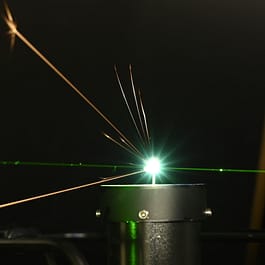



The test rig for laser-induced plasma spectroscopy (LIBS) is used for in-situ and non-intrusive analysis of the atomic composition of particle surfaces in reactive flows. The element-specific plasma radiation is excited by a pulsed ps laser. A lens focusses the radiation. Individual defined particles are introduced into the sample volume using the single particle seeder. Based on this, the plasma spectrum of the individual particles is measured under known conditions in order to analyse the influence of various parameters (particle size, surrounding gas phase, ...) on the measurement signal. Parallel to the LIBS, another measurement technique, the diffuse background illumination DBI, was integrated. This is crucial for detecting single hits of the LIBS system, as superimposed plasma radiation of different states occurs with several particles in the sample volume, which prevents a quantitative evaluation of the sample composition. The knowledge gained can then be used to determine the degree of oxidation on the particle surface in reactive processes by measuring the atomic composition. The plasma radiation is analysed using a detection unit consisting of a 1D imaging spectrometer, an image intensifier, which enables precise time-resolved measurement, and a CCD camera. A schematic representation of the LIBS set-up is shown in the figure.

SINGLE PARTICLE SEEDER
To diagnose the atomic composition on single particle surfaces, the influence of various factors on the measurement signal must first be analysed. This is done in the ODEE laboratory using single particles under clearly defined boundary conditions. The single particle seeder (see schematic illustration) allows the boundary conditions to be varied and enables the separation and defined feeding of individual particles into the sample volume of the LIBS test stand. The particles are introduced into the positive electrode as a bulk material.
The particles are aerosolised by applying a high voltage between the positive and negative electrodes. A defined volume flow applied via the plenum in which the two electrodes are located then transports individual particles into the sample volume via a capillary tube. This particle jet is surrounded by a coflow (sheath flow). To vary the gas phase surrounding the particle, both volume flows can be mixed from different gases in a defined manner using mass flow controllers. Furthermore, the plenum can be flooded in advance with the defined gas composition.

PENETRATION DEPTH OF LIBS LASER
A crucial parameter in the evaluation of the LIBS spectra is the particle volume transferred into the plasma, which is defined by the penetration depth of the LIBS laser. Initial measurements using a confocal microscope of the penetration depth for pure iron sheets showed approximately 2 µm. To determine the differences between metal sheets and particles, individual particles were captured after the laser shot and analyzed under a scanning electron microscope. The image clearly shows the melted particle surface on the right-hand side of the particle. This is followed by a transition in which the molten material has solidified and the natural surface of the iron particles on the left-hand side of the particle. These measurements show very clearly that the penetration depth of 2 µm also applies to particles.

EQUIPMENT
